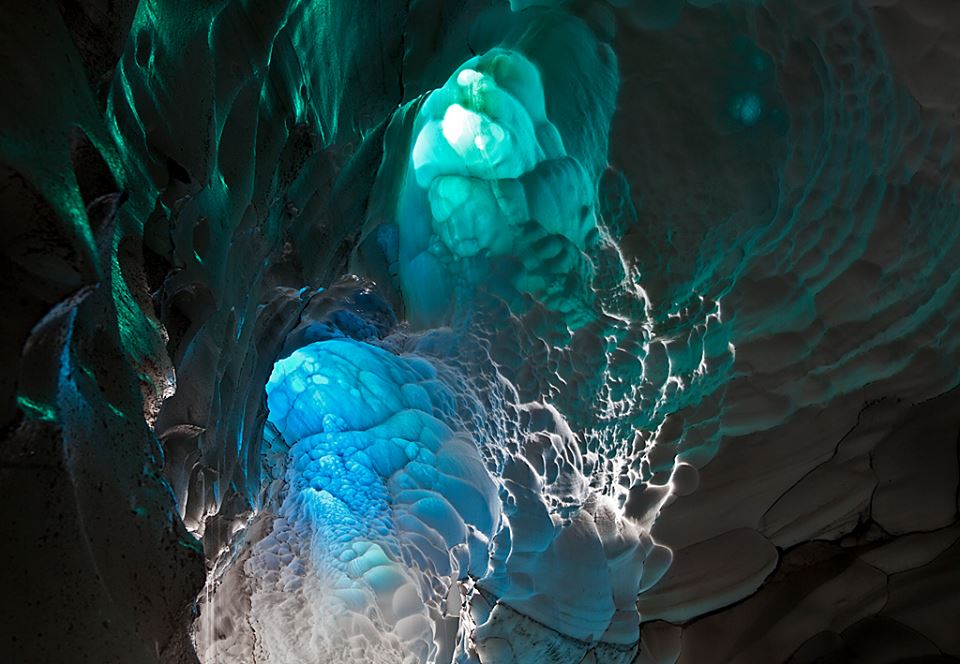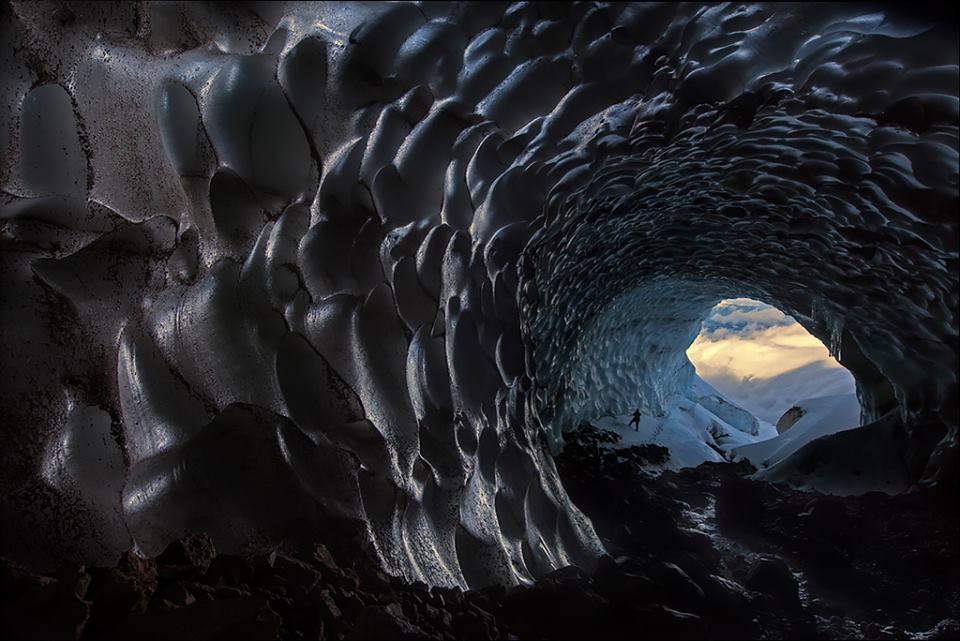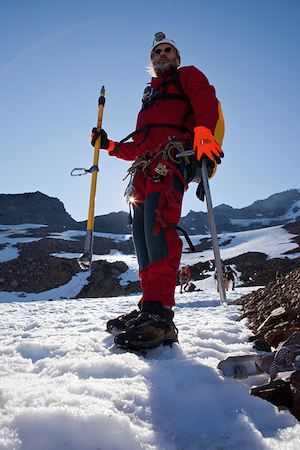For Brent McGregor, the glacier caves of Mount Hood are a place of endless fascination.
McGregor (portrait by Katie Campbell) is a 62-year-old caver and mountaineer who serves as chairman of the Oregon High Desert Grotto. He and his caving partner Eddy Cartaya discovered the largest glacier system in the lower U.S. five years ago, at the toe of the Sandy Glacier on the west side of Mount Hood. Since then the two explorers and their colleagues have mapped and photographed the caves meticulously, while collecting all sorts of data to document the rapid transformation of a hidden world that will not exist for long.
The ice in the caves they discovered is melting rapidly as climate change does its work. The large cave they call Snow Dragon recently collapsed, 5-10 years earlier than expected, and the other caves they are studying are expected to vanish over time.
That adds to the complexity of the phenomenon they are studying — and to the urgency to move quickly, before the caves are gone.
But when McGregor describes his work on Mount Hood, it quickly becomes clear that he doesn’t really consider it just work. For one thing, there is the thrill of exploring a new world. In caver’s parlance, this is known as “pushing leads,” or following an underground passage as far as it can be followed. “Cavers like to explore caves, push leads, and make maps,” says McGregor. “Every time we go up there we find new leads. Parts of the cave have become melted out, and stream passages are boring in new tunnels. It’s an evolving, dynamic environment.”
Most of the passages are huge, almost 100 feet across and up to 40 feet high from the bedrock to the ceiling, an ever-changing playground for the experienced caver and an environment of gorgeous light and color — though definitely not recommended for the inexperienced wanderer.

‘We are walking around for a mile with 100 feet of ice over our heads’
McGregor is not a trained scientist, more a deeply curious lay person, but scientists have recognized the value of the research he and Cartaya are completing on Mount Hood. A team of NASA scientists is applying for a multi-million-dollar grant to build on their findings using sophisticated equipment.
As McGregor explains, “Glaciologists and scientists very rarely go underneath the ice. All their studies are done on the surface, and even with light penetrating machinery they can only go so far. So even though they make a lot of studies and measurements and everything, what we are doing is different because we are walking around for a mile with 100 feet of ice over our heads. And I think it may have some importance scientifically, because you’re seeing what is happening underneath the glacier.”
Another thing that keeps McGregor returning to the caves is the wildlife. He has seen everything from coyotes to deer to small ice crawlers called grylloblattids. “An elk ran across the glacier during one of our expeditions,” he says. “Another time, on a solo trip, I ran right into a black bear. It was a huge black bear, the biggest bear I’ve seen in Oregon.”
McGregor and his colleagues have found conifer seedlings growing up from seeds that were frozen in the ice. “They’ve been in there for probably 100 years, and they’re starting to sprout… It’s a treasure hunt and a time capsule. You never know what’s going to melt out of that ice.”
And then there is the light. As you can see, McGregor is an accomplished photographer, and his images from inside the Sandy Glacier capture light and color in exquisite ways. “When the sun sets in Portland, the light comes in through the big bullet-hole openings, and it just makes the most beautiful colors in there,” he says. “It’s stunning.”

‘Glaciers around the world are going away’
100 years ago, the area where McGregor and his colleagues camp on Mount Hood would have been buried under feet of solid ice. This year, for the first time ever, people can drive right up to a trailhead near the glacier caves at the peak of winter.
“It doesn’t matter what side of the climate change debate you are on,” says McGregor. “Here is the fact: The caves are going away at an accelerated pace. You can argue all you want, but the fact is, glaciers around the world are going away. Ice is melting globally.”
The caves McGregor studies are at the toe of the Sandy Glacier. And while the upper reaches of the glacier are still fairly healthy, the ice lower down is rapidly melting and flowing down into the Pacific Ocean by way of the Sandy and Columbia Rivers.
The melt-down recently caused two large skylights to open up on the Snow Dragon cave. And then the area between the two skylights collapsed, closing off a large section of that cave. Fortunately, no one was inside the cave when it collapsed.
Here is a photo McGregor took of the interior of Snow Dragon, pre-collapse:

‘The mountain is going to become more dangerous’
Sometimes when McGregor approaches caves, he hears the loud crashes of ice and rocks falling off of the ceiling deeper inside. “I can’t see it but I can hear it rumbling down,” he says. “And I won’t go in, because it’s just a death zone.
“As you go, you learn about the potential hazards. You learn where to walk, where to go, where to stand and where not not to stand. There are rocks embedded in the ceiling, and when they melt out they’re gonna fall.”
McGregor has done a lot of climbing in the Cascades, with a summit of Mount Rainier and six or seven routes up Mount Hood, and he believes that “as this ice melts away, the mountain is going to become more dangerous.”
That’s because “our volcanoes are very disintegrative,” he explains. “They are very loose and crumbly. So when that snow isn’t holding the rocks together, there’s going to be a lot more rockfall and more accidents. And I think we’re seeing that now.”
Several recent accidents on Mount Hood have involved climbers and snowboarders falling down into holes that may be growing larger after two winters of abnormally high temperatures on Mount Hood. In August of 2013 Collin Backowski, a 25-year-old snowboarding coach, died in an ice tunnel on the mountain when a chunk of ice the size of a school bus broke loose and fell on him.
McGregor and Cartaya and their team have only experienced one minor injury while exploring the glacier caves. They recently reported to the National Speliological Society about their research and findings on Mount Hood, and they plan to continue with their expedition, safely, meticulously, and for as long as possible — as long as the glacier caves they are exploring still exist.
You can learn more about the project and see more of McGregor’s beautiful photos at the Glacier Cave Explorers Facebook Page. You can also download their recent presentation to the National Speleological Society here.
Also worth seeing is an excellent multimedia piece from Oregon Public Broadcasting about the glacier caves here.
And here is a slide show of images captured by McGregor during his expeditions, to give you a sense of the mystery and beauty of the world he and his colleagues are having so much fun exploring:
{igallery id=9474|cid=47|pid=2|type=category|children=0|addlinks=0|tags=|limit=0}
Last modified: March 4, 2015


